Angie Rubio’s last name means “blond” in Spanish—isn’t that funny? As an elementary schooler, she thinks it’s a great joke, despite the fact that her white friends don’t seem to understand. Angie has dark hair and Brown skin, just like the rest of her family, and as she grows older, she finds it’s not just her jokes that her friends don’t seem to get.
Donna Miscolta’s Living Color: Angie Rubio Stories, a collection of linked stories mostly set in the 1960s and 1970s in California, is filled with these little gems. Through this moment and others, Angie, a Mexican-American Navy brat, finds that she is different from her classmates. She does not have blond hair, or blue eyes, and she certainly doesn’t have the popularity of her peers that do. She is often alienated and abandoned by the school pack, left feeling the ‘alone’ that so many of us feel when we’re not meant to feel the belonging orchestrated by those who apparently have the say-so. “Popularity isn’t everything,” Angie’s mother frequently says.
Jaded Ibis Press website.
As the book follows Angie from kindergarten up to her senior year in high school, she explores a myriad of relationship dynamics at home and at school, and there are often disconnects. For one, Angie’s mother does not speak Spanish directly to her children, so Angie and her siblings often wonder what her mother is saying to her aunt—especially when they one day decide to give Angie and her sister unexpected perms.
When Angie’s family finally settles in California, where her father explores a new career after the Navy, she begins to foster stronger connections to her new community and to herself. Best friendships fade, microaggressions become unbearable, and her passion for writing and activism burgeons.
As Angie enters adolescence, her wit and bravery shine as her intolerance for systemic racism against herself and her family grows. She is shy, but holds her own against the onslaught of a privileged white narrative imposed on her every day at school. At home her older sister, Eva, the smart one, frequently reminds her, especially during the toughest moments of Angie’s self-realization, that they, indeed, are different. This time, however, it’s a fact that Angie begins to embrace.
Angie’s high school years are a true pleasure to behold—a young woman coming into her own and moving toward a promising future. She enjoys speech club, takes advanced classes, and even tries out with her best friends for cheerleading. Despite her friends’ triumphs, they are still often silenced or rejected because of their differences from popular girls like Judy. “Brown power,” they say together, knowing they will soon be able to escape their high school’s ongoing oppression.
Donna Miscolta’s Living Color is an intimate exploration of the intersectional identity of a young Mexican-American girl, and the tensions between what she’s been told is true and the truth itself. Just as Angie takes a powerful step forward in determining her own future, her own way, Latinx youth should all keep these words close to the chest: Brown power, for today and for tomorrow.
Chelsea Villareal is a Queer Mexican-American Children’s Media Strategist from Portland, Oregon. She holds a BUPA in Political Science & Media Studies from Portland State University and is currently enrolled in her Masters at Columbia University, TC. She works on the Brand Marketing team at Penguin Young Readers and also holds down the role of Program Manager at We Need Diverse Books. She lives in Brooklyn with her partner and two crazy, lazy feline beasts.









